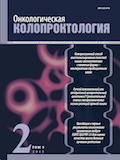Vol 5, No 2 (2015)
- Year: 2015
- Published: 17.07.2015
- Articles: 7
- URL: https://onco-surgery.info/jour/issue/view/17
Full Issue
 6-6
6-6


REVIEW
Selection of surgical approach and role of lymph node dissection at colorectal cancer
Abstract
Historically, colorectal surgeons extended lymph nodes dissection level. However, it is still controversial issues: what is considered to be an extended lymph node dissection, why and to whom it is better to do it, etc. Moreover, the prognostic value of extended lymph dissection was demonstrated in trials with a low level of evidence and has different degrees of recommendation in different countries and regions. On one hand positive apical lymph nodes in colon cancer achieves 17 % and its risk increasing with tumor penetration into bowel wall, and it is an independent negative prognostic factor with 5 years overall surveillance less 45 %. An indirect data (increased the number of lymph nodes, integrity of removed mesocolon, lymphovascular length, etc.) showed better outcomes with extended lymph node dissection. More controversy is extended lymph node dissection for rectal cancer, the current standard of treatment which is at chemoradiotherapy and/or total mesorectumectomy for T3–4N0–2. Because there is no evidence that lateral pelvic node dissection in rectal cancer improves disease-free survival and overall survival, as well as high ligation of the inferior mesenteric artery. And the presence of pelvic and inferior mesenteric lymph node metastases, identifying average in 7 %, is associated with a high level of local recurrences till 44 % and low survival rate not more 42 % in 5 years. The answer to this question may be conducting multicenter randomized trials.
 7-13
7-13


ORIGINAL REPORTS
Compression method of anastomosis of large intestines by implants with memory of shape: alternative to traditional sutures
Abstract
Research objective. To prove experimentally the possibility of forming a compression colonic anastomoses using nickel-titanium devices in comparison with traditional methods of anastomosis.
Materials and methods. In experimental studies the quality of the compression anastomosis of the colon in comparison with sutured and stapled anastomoses was performed. There were three experimental groups in mongrel dogs formed: in the 1st series (n = 30) compression anastomoses nickel-titanium implants were formed; in the 2nd (n = 25) – circular stapling anastomoses; in the 3rd (n = 25) – ligature way to Mateshuk– Lambert. In the experiment the physical durability, elasticity, and biological tightness, morphogenesis colonic anastomoses were studied.
Results. Optimal sizes of compression devices are 32 × 18 and 28 × 15 mm with a wire diameter of 2.2 mm, the force of winding compression was 740 ± 180 g/mm2. Compression suture has a higher physical durability compared to stapled (W = –33.0; p < 0.05) and sutured (W = –28.0; p < 0.05), higher elasticity (p < 0.05) in all terms of tests and biological tightness since 3 days (p < 0.001) after surgery. The regularities of morphogenesis colonic anastomoses allocated by 4 periods of the regeneration of intestinal suture.
Conclusion. Obtained experimental data of the use of compression anastomosis of the colon by the nickel-titanium devices are the convincing arguments for their clinical application.
 14-26
14-26


Comparative analysis of laparoscopic low rectal resections
Abstract
 27-35
27-35


Validation and the first results of clinical use of an EORTC QLQ PRT-23 module to assess quality of life in patients with radiation-induced rectitis
Abstract
 36-40
36-40


CASE REPORT
Abdominosacral resection in the surgical treatment of rectal cancer
Abstract
Surgery is the only potentially radical treatment option for locally advanced and recurrent rectal tumors invading the sacral vertebrae. However, the choice of tactics for this patient category remains a difficult task. In spite of the fact that chemoradiation therapy yields good results, it is very difficult to differentiate postradiation changes and residual tumor; the immediate results of combined surgical interventions accompanied by sacral resection remain unsatisfactory, which restricts their use in routine practice and the frequency of unradical operations and local recurrences remains high.
Optimization of the results of abdominosacral resection in patients with rectal cancer requires that the definite principles should be adhered to. The chief task of treatment (radical surgery) is fulfilled via resection of the sacrum and, if indicated, other organs even to the extent of performing total pelvic evisceration. In the present view, radiotherapy is a compulsory component of combined treatment that enhances surgical radicalism. However, its impact on the results of this intervention type has been inadequately studied so far. Careful selection of patients to undergo abdominosacral resection determines high requirements for preoperative tumor imaging techniques. Due to their technical complicacy, it is recommended that this operation should be made only by specialized cancer centers having capacities for performing combined treatment for colorectal cancer.
 41-44
41-44


A case-report of synchronous adenocarcinoma and gastrointestinal stromal tumor of the colon
Abstract
Synchronous colonic tumors of different morphology are rarely described in the literature and do not have a clear ethiological connection. This fact is the key to a more detailed study of the clinical and morphological and molecular genetic features of different gistotipov synchronous tumors. There is increasing publications and clinical observations of simultaneous coexistence of adenocarcinoma and gastrointestinal stromal tumor. A separate and very valuable space is given interaction surgeons oncologists and pathologists. Today, for the correct pathological diagnosis of synchronous tumors of different biological nature, it is obligatory to conduct immunohistochemical study. Data on the results of treatment of synchronous tumors must necessarily be recorded in the cancer registries. Based on that, the developed algorithms timely diagnosis and proper treatment strategy in the cohort of patients. We present a case report of a 56 year old patient with a rare synchronous epithelial and non-epithelial colon tumors.
 45-50
45-50











